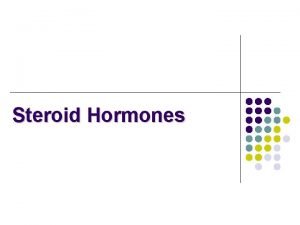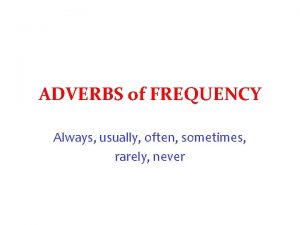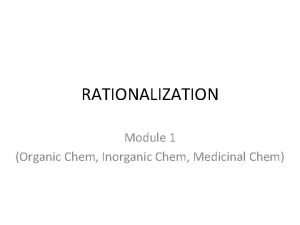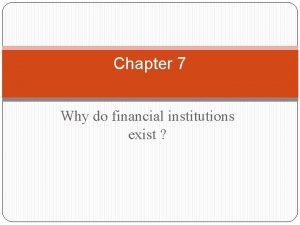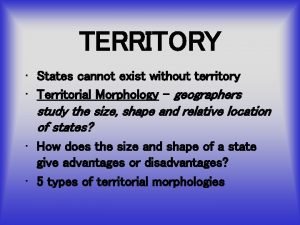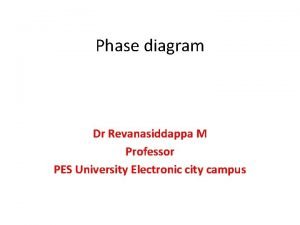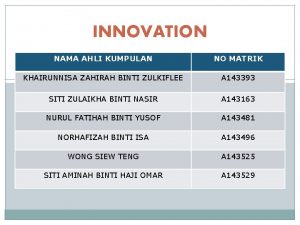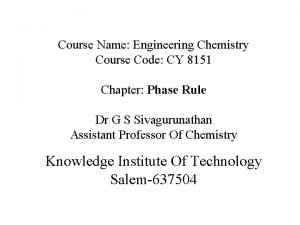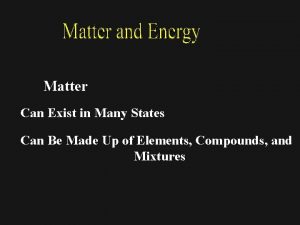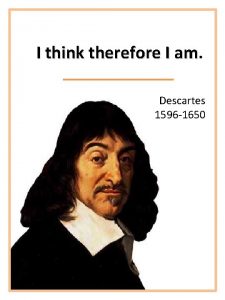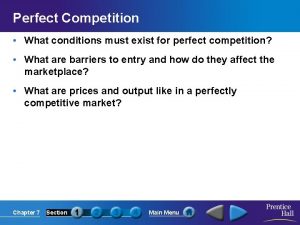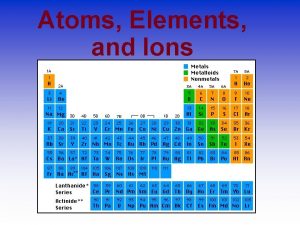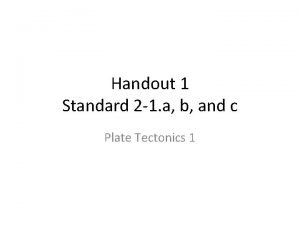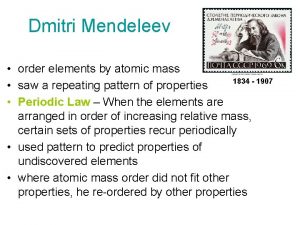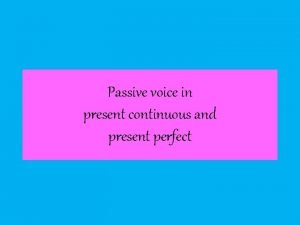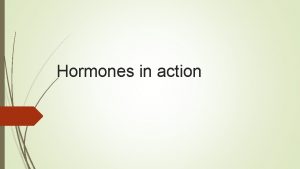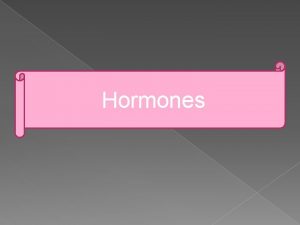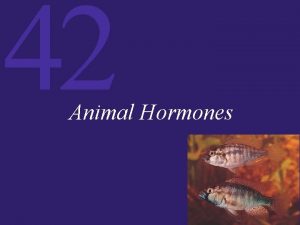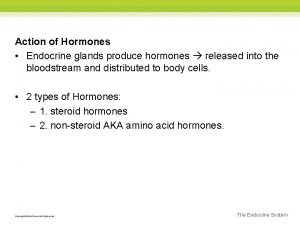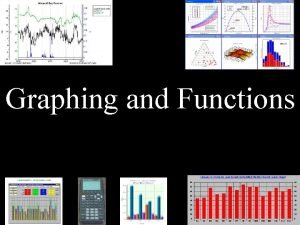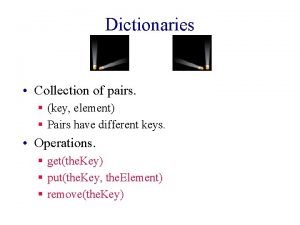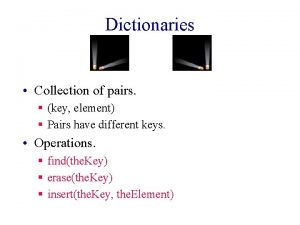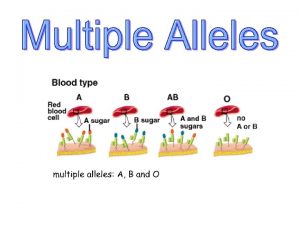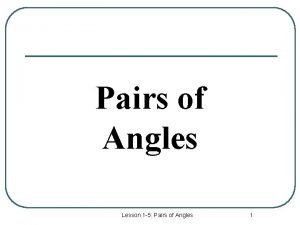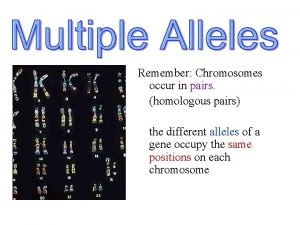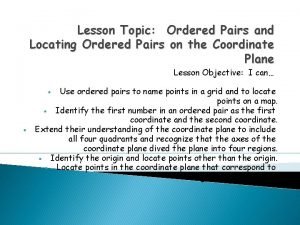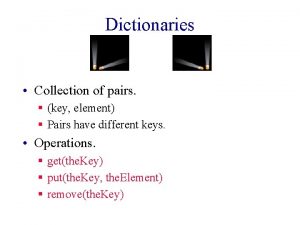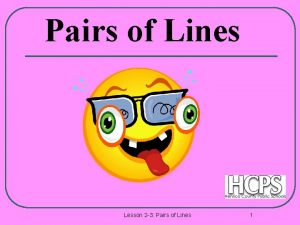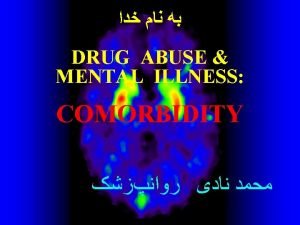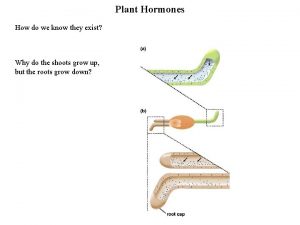Hormones in Action Hormones Often exist in pairs


































- Slides: 34

Hormones in Action

Hormones • Often exist in pairs – One hormone to trigger an effect – One hormone to stop or reduce the effect • Homeostasis requires the balance between these two hormones that allows the body to stay regulated

Chemical communication in animals • Hormones! – Affect specific target cells Either – Steroid hormones – soluble in lipids and able to pass through cell membrane – Amino acid and polypeptide-based hormones – unable to pass through cell membrane • Note that hormones may target only a very few cells or many cells depending on their type – Oestrogen only binds to uterus, breasts and bone • Note that the same cell can act as a target for many hormones.

Receptor proteins • Receptor proteins are on cell membrane for amino acid and polypeptide-based hormones • Receptor proteins are in cytoplasm for steroid hormones • Hormone molecule can only bind to target cells as their protein receptors have the complementary configuration for the hormone – Similar to enzyme/substrate relationship

Transferring the message through the cell – secondary messenger method • Hormone molecule binds with its receptor protein – This is associated with adenylate cyclase on the inner membrane • Adenylate cyclase is thus activated – This catalyses conversion of ATP molecules to cyclic AMP in the cytoplasm (the secondary messenger) • The cyclic AMP molecules then activate enzymes within the cell to trigger the response • After the cell has responded cyclic AMP is degraded


Transferring the message through the cell – direct to nucleus method • Steriod hormones enter the cytoplasm directly through cell membrane and may move into the nucleus. • Here they will interact with a specific protein receptor molecule, which if not in the nucleus will move in as a hormone-receptor protein complex • Here it interacts with the DNA and adjusts the cells function by turning on or off genes.

Blood Glucose Homeostasis

Regulation of blood glucose levels • Normal range of glucose in blood is 3. 0 – 7. 7 mmol/L • Glucose concentration in blood and tissue is determined by 1. Cellular respiration (how much glucose is being used)

Regulation of blood glucose levels 2. Conversion of glucose into glycogen – when there is excess glucose. It is stored as glycogen in the liver and some in muscles

Regulation of blood glucose levels 3. Conversion of glucose into fat – when there is excess glucose. It is stored as fat in tissues as fat deposits 4. Glucose may be produced from the break down of complex compounds such as glycogen and fat

Blood glucose regulation hormones • Insulin – Released when blood sugar levels are high in order to reduce them • Glucagon – Released when blood sugar levels are low in order to increase them • Both secreted into blood stream by cells in pancreas in an area called Islet of Langerhans

High blood sugar levels • Insulin is secreted by beta cells in the islet of langerhans • Insulin targets muscle and liver cells. • Insulin binds with a receptor molecules in the cell membrane activating protein kinase • This then activates activities of other enzymes within the cell. • The protein kinase is the second messenger in the signal transduction

High blood sugar levels cont. • Insulin signals to cells that the blood glucose levels in blood need to be reduced • The cells can respond by – Increasing uptake of glucose – Convert glucose to glycogen and fat if in surplus – Inhibit or reduce conversion of glycogen to glucose • When blood glucose levels are reduced, pancreas cells secrete less insulin

• Draw this as a flowchart to demonstrate how the body responds when glucose levels are high

Low blood glucose levels • Hypoglycaemia • Glucagon is secreted by alpha cells in the islet of langerhans • Glucagon also targets liver and muscle cells. • It binds to the cell membrane receptors but must use c. AMP as a second messenger to convey its message. • c. AMP will active protein Kinase A to alter the activity of a range of enzymes. • The result of this is glycogen and fat will be converted into glucose.

Low blood sugar cont. • Glucagon will also target beta pancreatic cells – Siganaling that insulin production is not required. • Overall blood sugar levels should increase • When this has occurred the pancreas will reduce secretion of glucagon.

• Draw a flow chart to demonstrate how the body responds when glucose levels are low

Blood glucose regulation gone wrong • When the body cannot balance its insulin and glucagon hormones, diabetes occurs

Regulating Metabolism • Thyroid hormones (thyroxines) are the main hormones in controlling metabolism – Cellular differentiation – Growth – metabolism • Thyroxine is composed of amino acid tyrosine and also iodine • Has different effects on different cells at different stages of development


Signalling pathway of thyroxine • Although amine-based, it can move through the cell membrane by diffusion – is small enough – hydrophobic in nature • Therefore it is able to go directly though the cytoplasm and into the nucleus where it binds to specific receptors. • the thyroxine-receptor complex then regulates the expression of genes within the cell (the cell response)

Control of thyroxine production • Must be secreted at a constant rate as it has important effect on all cells. But may also need to be increased at particular times – This is achieved by a negative feedback system

Metabolism gone wrong • Issues with control and production of thyroxine – Hyperthyroidism: too much thyroxine. This is caused by an overactive thyroid – Hypothyroidism: not enough thyroxine. This is caused by an underactive thyroid

Hyperthyroidism • Higher than normal basal metabolic rate • Symptoms – – – Feeling hot Weight loss Fast pulse rate Feeling restless Trouble sleeping Shortness of breath, chest pain, muscle weakness • Treatment – Radioactive iodine – Surgery to remove/part remove thyroid – Drugs to reduce activity.

Hypothyroidism • Underactive thyroid or lack of iodine in diet. • Slow metabolism • Symptoms – – – Fatigue Weight gain Sensitivity to cold Muscle cramps Depression Poor concentration • Treatment – Taking thyroxine supplements

Goitre • Swollen thyroid gland – the thyroid is not synthesizing the thyroxine hormone, – TSH is being sent to thyroid to signal need for more thyroxine. – It can’t respond. TSH keeps being sent. – It will then produce more cells to try to keep up with thyroxine production.

Very little is sent in overactive Keeps being sent if underactive

Regulating growth and development • Somatotrophin (main growth hormone) – Protein hormone – Originates from pituitary gland – Increases metabolic rate in bone ends, muscles – Uses protein kinase receptor on cell membranes of target cells as a second messenger

Control of secretion of growth hormone • Controlled by hypothalamus – Increases secretion by pituitary gland • Releases growth hormonereleasing hormone (GHRH) – Decrease growth hormone secretion • Releases somatostatin • Factors that can affect secretion of growth hormone: – Stress, exercise, nutrition, sleep, amount of growth hormone – Because ghrelin is secreted by stomach when body is in stress. It binds to pituitary and hypothalamus and increases growth hormone. Relationship not fully understood


Growth regulation gone wrong • Too much hormone in a child – Gigantism – Increased growth of entire body • Too much hormone in an adult – Acromegaly – Enlarged jaw, hands or feet

Growth regulation gone wrong • Not enough hormone in a child – dwarfism – Stunted growth or short stature – Can be treated with injections in children • Not enough hormone in an adult – Cannot be treated

 Ammonia bond angle and shape
Ammonia bond angle and shape Lipid soluble hormones
Lipid soluble hormones Nervous system vs endocrine system venn diagram
Nervous system vs endocrine system venn diagram Transcortin
Transcortin Always usually often sometimes seldom never
Always usually often sometimes seldom never Sulfurated potash
Sulfurated potash Why do financial institutions exist
Why do financial institutions exist European microstates
European microstates You cant manage what you dont measure
You cant manage what you dont measure Pattinson process phase diagram
Pattinson process phase diagram Anggota kumpulan exist
Anggota kumpulan exist What makes a limit not exist
What makes a limit not exist A current is said to exist whenever _____.
A current is said to exist whenever _____. Define degree of freedom
Define degree of freedom What is the main conflict in marriage is a private affair
What is the main conflict in marriage is a private affair In what region did racial etiquette exist
In what region did racial etiquette exist Does dash still exist
Does dash still exist Matter can exist as
Matter can exist as The nine-cell attractiveness-strength matrix
The nine-cell attractiveness-strength matrix I think therefore i am
I think therefore i am For an industry to be perfectly competitive what must exist
For an industry to be perfectly competitive what must exist Does magenta exist
Does magenta exist Php mysql create database if not exists
Php mysql create database if not exists Do ghosts really exist
Do ghosts really exist Why businesses exist
Why businesses exist Which elements exist as diatomic molecules
Which elements exist as diatomic molecules Bagian rhizopus
Bagian rhizopus Occurs when an entire species ceases to exist
Occurs when an entire species ceases to exist Why do markets exist
Why do markets exist Why do shadow zones exist
Why do shadow zones exist What is development gap?
What is development gap? I cannot exist without you john keats
I cannot exist without you john keats M in periodic table
M in periodic table A weak entity set can exist alone
A weak entity set can exist alone Passive voice in present perfect continuous tense
Passive voice in present perfect continuous tense



